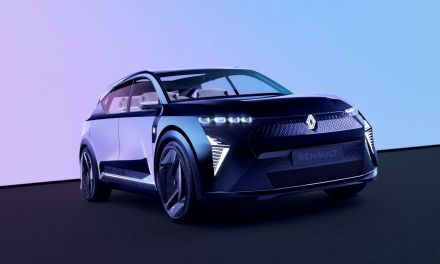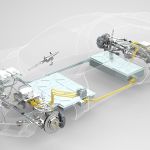At an event at STATION-Berlin in mid-September presenting its electrification technology strategy for its vehicles, Daimler Trucks revealed its hydrogen-based fuel-cell Mercedes-Benz GenH2 truck concept and a preview of the battery-powered eActros LongHaul. High-level presenters at the event included Martin Daum, Chairman of the Board of Management of Daimler Truck AG and Member of the Board of Management of Daimler AG; Sven Ennerst, Member of the Board of Management of Daimler Truck AG for Development, Procurement and the China Region; and Andreas Scheuer, Federal Minister of Transport and Digital Infrastructure.
The GenH2 Truck demonstrated for the first time the specific technologies so that heavy-duty fuel-cell trucks can perform long-distance haulage with ranges of 1000 km (620 mi) and more on a single tank of hydrogen. The company plans to begin customer trials of the truck in 2023, with series production planned in the second half of the decade. Thanks to the use of liquid (instead of gaseous) hydrogen with its higher energy density, the vehicle’s performance is planned to equal that of a comparable conventional diesel truck. In a pre-series version, two electric motors are designed for a total of 2 x 230 kW continuous power and 2 x 330 kW maximum power. Torque is 2 x 1577 N·m and 2 x 2071 N·m, respectively.
Plans call for an eActros LongHaul to be ready for series production in 2024 with a range of about 500 km (310 mi). It is a follow on from the eActros for distribution transport presented in 2018, which has been tested intensively since then by customers in transport operations. The company will start series production of a purely battery-powered heavy-duty truck next year, the range of which is promised to significantly exceed the 200 km (124 mi) of the prototype.
Daimler Trucks is pursuing similar vehicle schedules for the European, North American, and Japanese markets. By the year 2022, its portfolio in those main sales regions is to include series-produced vehicles with a battery-electric drive. The company also has an ambitious plan to offer new vehicles that are CO2-neutral in driving operation (from tank to wheel) in Europe, North America, and Japan by 2039.
A new worldwide modular platform architecture, called ePowertrain, will be the basis of all medium- and heavy-duty CO2-neutral, all-electric trucks, whether powered purely by batteries or by hydrogen-based fuel cells. With the ePowertrain, the company promises high levels of performance, efficiency, and durability—while achieving synergies and economies of scale for all relevant vehicles and markets.
Martin Daum outlined the vision of CO2-neutral transport that has the best potential to succeed in the market in the long term: “Battery power will be rather used for lower cargo weights and for shorter distances. Fuel-cell power will tend to be the preferred option for heavier loads and longer distances.”
He added that “to make CO2-neutral all-electric vehicles competitive, regulatory and government action is needed, including the necessary infrastructure for charging with green electricity and for the production, storage, and transport of green liquid hydrogen.”
For the headlining GenH2 Truck concept, it is targeted at the capabilities of the conventional Mercedes-Benz Actros long-haul truck with regard to power, range, and performance. The series-production version is to have a gross vehicle weight of 40 ton (36 t) and a payload of 25 ton (23 t). Two special liquid-hydrogen tanks and a powerful fuel-cell system will make this high payload and long range possible. Daimler experts are developing the liquid-hydrogen tanks closely with an unnamed partner and combining that with their decades of experience in fuel-cell technology and production processes.
In April, Daimler announced an agreement with the Volvo Group to establish a new joint venture to accelerate the development, production, and commercialization of fuel-cell systems for use in heavy-duty commercial vehicles and other applications. To facilitate the joint venture, Daimler Truck AG brought together all group-wide fuel-cell activities in a new subsidiary called Daimler Truck Fuel Cell GmbH & Co. KG.
Daimler prefers to use liquid (vs. gaseous) hydrogen (LH2) because of its far higher energy density. Storage tanks can be much smaller, lower pressure, and significantly lighter—giving trucks a larger cargo space and higher payload weight. And more hydrogen can be carried, which significantly increases the trucks’ range. This all makes the GenH2 Truck suitable for multi-day, difficult-to-plan, long-haul transport for which the daily energy throughput is high. However, challenges include the storage of cryogenic liquid hydrogen at -253°C (-423°F), though this is already common practice in stationary applications (at hydrogen filling stations) and for the transport of liquid hydrogen as cargo.
The two stainless-steel liquid-hydrogen tanks intended for the series GenH2 Truck will have a high storage capacity of 40 kg (88 lb) each for covering long distances. The tank system consists of two tubes, one within the other, that are connected to each other and vacuum-insulated. In the series application, the fuel-cell system will supply 2 x 150 kW.
A supplemental battery will provide an additional 400 kW. At 70 kW·h, battery storage capacity is relatively low, as it is not intended to meet energy needs but mainly to provide situational power in support of the fuel cell during peak loads—while accelerating or while driving uphill fully loaded. The relatively light battery allows a higher payload and will be recharged with braking energy and excess fuel-cell energy. A core element of the fuel-cell and battery system operating strategy is a cooling and heating system that keeps all components at the ideal operating temperature.


















































































